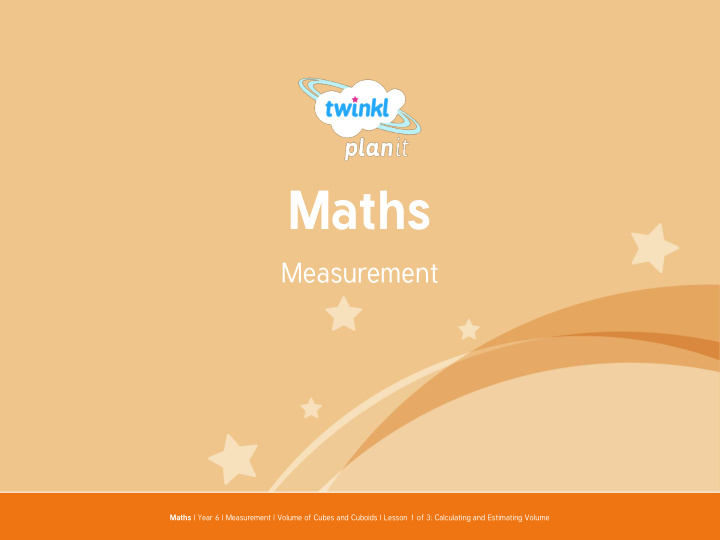



Maths Measurement Maths | Year 6 | Measurement | Volume of Cubes and Cuboids | Lesson 1 of 3: Calculating and Estimating Volume
Aim • I can estimate and calculate the volume of cubes and cuboids. Success Criteria • I can count cubes in a layer to help me estimate the volume of cubes and cuboids. • I can use a formula to calculate volume of cubes and cuboids.
Make the Shape Roll a dice 3 times. Multiply the numbers you roll. Make a 3D shape with this number of small cubes. Were you able to make a cube or a cuboid? Talk to your partner about why you could or could not make a cube or cuboid.
What Is Volume? With your partner, write a definition for volume. Volume = the amount of 3D space taken up by something. When measuring the volume of a fixed object (where the shape doesn’t change), we use cubic units. Today we are going to use cubic centimetres and cubic metres to measure and estimate the volume of cubes and cuboids.
What Is Volume? We can find the volume of these shapes made from 1cm³ multilink cubes by counting the number of 1cm³ cubes that make up each shape. Remember that some shapes have cubes that are hidden from sight! 10cm³ 13cm³ 15cm³
Calculating Volume of Cubes and Cuboids We can calculate the volume of cubes and cuboids by counting cubes in layers: In the top layer, there are 6 cubes (3 × 2). There are 4 layers. 1 2 3 × 2 × 4 = 24 3 If each cube were a cubic centimetre, this would be 24 cubic centimetres, which we 4 could write as 24cm³.
Calculating Volume of Cubes and Cuboids Count the top layer of each shape and calculate the volume. The unit measurement is shown underneath. cubic cubic metres cubic centimetres centimetres 36cm³ 48m³ 32cm³
Calculating Volume of Cubes and Cuboids There is a formula to calculate volume. Do you know another way to calculate the volume of cubes and cuboids? length × width × height Use the formula to calculate the volume of the following shapes. 4m 3cm 8cm 8m 6cm 5cm 54cm³ 192m³ 240cm³
Calculating Volume of Cubes and Cuboids On these shapes, one cube has been drawn. Each cube is a cubic centimetre. Estimate the volume. 12cm³ 27cm³ 18cm³
Calculating and Estimating Volume Use your fabulous calculation and estimation skills to complete these activity sheets.
Diving into Mastery Dive in by completing your own activity!
Draw That Shape! Lewis has estimated that a shape has a volume of 60cm³. On your isometric paper, draw a cube or cuboid which would have a volume of 60cm³. There are many possible solutions. 5cm 5cm 2cm 6cm 3cm 2cm 5cm 4cm
Aim • I can estimate and calculate the volume of cubes and cuboids. Success Criteria • I can count cubes in a layer to help me estimate the volume of cubes and cuboids. • I can use a formula to calculate volume of cubes and cuboids.
Recommend
More recommend